
Initial Comparisons of Model Lightning Frequency Parameters To Space-based Lightning Observations

Dr. Jonathan Smith
NOAA/Geophysical Fluid Dynamics Laboratory
Monday April 10, 2023, 2 PM ET
Hybrid (In-Person & Virtual):
This seminar will be held at room 4102 of ESSIC, 5825 University Research Ct. College Park, MD 20740. In-person attendance is welcome with refreshment provided. Zoom is also provided for virtual participants.
Abstract:
Comparisons of GFDL’s Atmospheric Model 4 (AM4) model flash frequency (ff, flashes/km2/seconds in a month) from 2018-2020 are made to ff on the novel GOES-16 and -17 Geostationary Lightning Mappers (GLMs). The high resolution GLM observations are regridded to the spatial resolution of 1° latitude to 1.25° longitude. The analysis suggests that the GLM observes higher flash frequencies than the AM4 model predictions by 2 orders of magnitude (1×10-5 to 1×10-7) in the Northern Hemisphere (NH) summer and 1 order of magnitude (1×10-5 to 1×10-6) in the Southern Hemisphere (SH). With the notable exception of overpredictions in the North American Rocky and South American Andes Mountains throughout the years of 2018-20. The biases result in the mean 2018–2020 model to observe correlations of 0.5 or below over both land and ocean across the GLM field of view (FOV). To improve confidence in our results, this study compared the model output and GOES-16 GLM ff’s and biases to those in polar-orbiting TRMM-Lightning Imaging Sensor (LIS) and International Space Station – LIS. Within the GOES-16 GLM domain, the analysis found persistent low biases in the NH and in the SH downwind of the Andes throughout the 2018-2020 period. Higher mutual biases are found over northern South America. The overall flash rates (total flashes/second) over the GLM FOVs between the model and observations were comparable. To improve the model prediction of ff, we are currently examining AM4 Model and ERA5 Analysis Convective Available Potential Energy (CAPE) and total precipitation (as discussed in Romps et al. 2018) to assess their correlations with the AM4 model ff. We will analyze cloud water path and ice flux as these correlate well with ff in the literature. All of this work are preliminary steps to Earth System Model development of ff and lightning-nitrogen oxide parameterizations and analyses of current and future space-based lightning data.
Biosketch:
Dr. Jonathan Wynn Smith is a Physical Scientist at Geophysical Fluid Dynamics Laboratory in Princeton, NJ and a Visiting Scientist Appointment with UMD/ESSIC. At GFDL, Jonathan is comparing geostationary spaced-based lightning flash frequency observations to climate model predictions of flash frequency. This preliminary work will lead to future GFDL climate model development of lightning frequency and lightning-nitrogen oxide (LNOx) parameterizations. And subsequently improved estimates of ozone and methane. Jonathan has contributed to GOES-16 Geostationary Lightning Mapper gridded product training, Suomi NPP meteorology and chemistry product validation, Saharan Air Layer impacts on West African Squall lines, mesoscale convective systems, combined impacts of Arctic Oscillation and El Niño Southern Oscillation on temperature and precipitation. Jonathan has several lead author publications in these areas. Jonathan was a radiosonde/ozonesonde operator on land-based field campaigns in Cape Verde and Senegal and ship-based field campaigns that include the Dynamics of the Madden Julian Oscillation (DYNAMO), NOAA Aerosols and Ocean Science Expeditions Campaigns (AEROSE), and California Water II (CALWATER II) experiments. Jonathan received his Ph.D. in Atmospheric Sciences from Howard University in tandem with the role of Physical Science Trainee in the NASA Co-Op Program in the Atmospheric Chemistry and Dynamics Branch at the Goddard Space Flight Center. Jonathan quantified tropospheric ozone from biomass burning and LNOx using the WRF-Chem Model and Worldwide Lightning Location Network (WWLLN) flash locations. Jonathan has a M.S. in Meteorology from Pennsylvania State University and a B.S. in Physics from North Carolina Agricultural and Technical (A&T) State University.
Webinar:
Event site: https://go.umd.edu/jwsmith
Zoom Webinar: https://go.umd.edu/jwsmithwebinar
Zoom Meeting ID: 979 8618 3487
Zoom password: essic
US Toll: +13017158592
Global call-in numbers: https://umd.zoom.us/u/aMElEpvNu
For IT assistance:
Cazzy Medley: cazzy@umd.edu
Resources:
Seminar schedule & archive: https://go.umd.edu/essicseminar
Seminar Google calendar: https://go.umd.edu/essicseminarcalendar
Seminar recordings on Youtube: https://www.youtube.com/user/ESSICUMD

